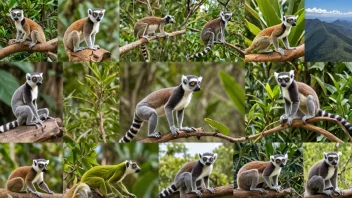South Africa is a country renowned for its breathtaking landscapes, rich culture, and especially its unique wildlife. With a vast array of ecosystems, from savannas and deserts to wetlands and forests, South Africa is home to an astonishing diversity of species, many of which are endemic or endangered. This article delves deep into the unique wildlife of South Africa, exploring its various national parks, conservation efforts, and the experiences that make this destination a must-visit for nature lovers and wildlife enthusiasts.
The Biodiversity of South Africa
One of the most remarkable aspects of South Africa is its biodiversity. The country boasts a whopping 299 mammal species, over 850 bird species, and countless reptiles, amphibians, and insects. The varied climate and geography create numerous habitats, each supporting different forms of wildlife. Here are some key highlights:
- The Big Five: South Africa is famous for the Big Five – lions, leopards, rhinoceroses, elephants, and Cape buffalo. These iconic animals are a major draw for tourists and can be seen in numerous reserves and parks.
- Marine Life: The country’s coastline, stretching over 2,500 kilometers, is teeming with marine life, including great white sharks, dolphins, and the southern right whale, which migrates to the coast to breed.
- Unique Flora and Fauna: The Cape Floristic Region is a UNESCO World Heritage Site, showcasing an extraordinary variety of plant species, many of which are found nowhere else in the world.
Notable National Parks and Reserves
South Africa is dotted with numerous national parks and reserves, each offering unique wildlife experiences. Here are some of the most notable:
Kruger National Park
Spanning nearly 20,000 square kilometers, Kruger National Park is one of the largest game reserves in Africa. It is home to an impressive array of wildlife, including the Big Five, and offers visitors the chance to experience self-drive safaris, guided tours, and walking safaris. The park's diverse ecosystems, from dense bushveld to open savanna, support a wide variety of species.
Addo Elephant National Park
Located near Port Elizabeth, Addo Elephant National Park is a sanctuary for elephants, with a population exceeding 600 individuals. The park also protects other wildlife, including lions, buffalo, and various antelope species. The unique coastal and semi-arid environments provide varied habitats for its inhabitants.
Hluhluwe-Imfolozi Park
This is the oldest proclaimed nature reserve in Africa and is renowned for its successful conservation efforts for the white rhinoceros. Visitors can enjoy self-drive safaris and guided tours, exploring the park's rolling hills and rich wildlife.
Unique Wildlife Experiences
Beyond traditional safari experiences, South Africa offers a range of unique wildlife activities that allow visitors to engage with nature more intimately:
Shark Cage Diving
For the adventurous, shark cage diving in Gansbaai provides a thrilling opportunity to encounter great white sharks up close. This experience not only gives you a chance to see these magnificent creatures but also raises awareness about their conservation.
Whale Watching
From June to November, the southern right whale migrates to the waters off the coast of South Africa to breed. Towns like Hermanus are famous for their whale-watching opportunities, where visitors can often see these gentle giants from the shore.
Bird Watching
Bird enthusiasts will find South Africa a paradise, with diverse habitats supporting hundreds of species. The Kruger National Park, the Cape Peninsula, and the iSimangaliso Wetland Park are all prime locations for bird watching.
Conservation Efforts in South Africa
With the increasing threat of poaching and habitat loss, conservation efforts in South Africa are more crucial than ever. Various organizations and government initiatives work tirelessly to protect the nation's wildlife:
- Anti-Poaching Units: Many national parks have established anti-poaching units to combat the illegal hunting of endangered species, particularly rhinos and elephants.
- Community Involvement: Programs that involve local communities in conservation efforts have been implemented. This not only helps protect wildlife but also encourages sustainable livelihoods.
- Wildlife Rehabilitation Centers: Facilities like the Cheetah Outreach and the African Penguin & Seabird Sanctuary focus on rehabilitating injured and orphaned animals, while also raising awareness about conservation.
Practical Tips for Travelers
If you're planning a trip to South Africa to explore its unique wildlife, here are some practical tips:
- Best Time to Visit: The dry winter months (May to September) are often considered the best time for wildlife viewing, as animals congregate around water sources and vegetation is less dense.
- Health Precautions: Be sure to consult with a healthcare professional regarding vaccinations and malaria prophylaxis, particularly if you plan to visit areas where malaria is present.
- Respect Wildlife: Always maintain a safe distance from animals, and follow the guidance of your tour guide or park ranger.
- Pack Accordingly: Bring binoculars for wildlife viewing, a camera for capturing memories, and comfortable clothing for varying temperatures.
Conclusion
South Africa's unique wildlife is an attraction that captivates visitors from around the globe. With its stunning landscapes, diverse ecosystems, and a commitment to conservation, the country offers unparalleled opportunities for wildlife enthusiasts. Whether you're embarking on a safari adventure, engaging in marine activities, or simply soaking in the natural beauty, South Africa promises an unforgettable experience. By understanding and participating in conservation efforts, travelers can contribute to preserving this extraordinary biodiversity for future generations.






